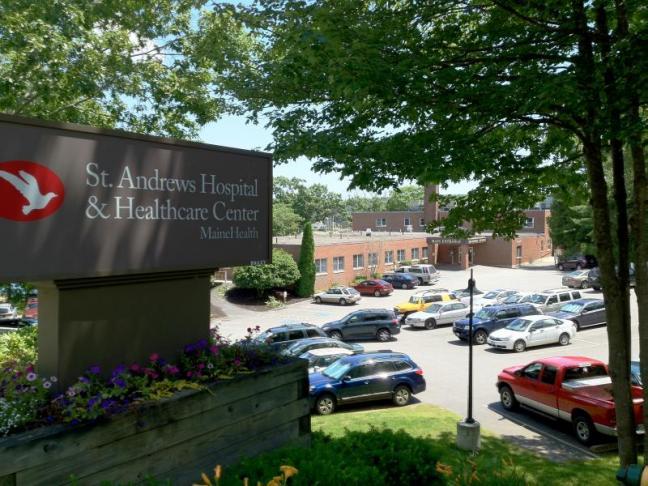How did we get here?
In the last few weeks, this community has expressed outrage over the proposed clinical changes at St. Andrews Hospital and the way those changes were announced. Blame has been assessed and accusations made in a highly charged stream of emotion and broken hearts.
Although the decision to close St. Andrews' emergency room and inpatient care came as a shock to the community, it was less shocking to those who have been involved with healthcare here and throughout the state.
Mary Lou Koskela, who served on the St. Andrews Board during the 1990s, said she wasn’t shocked by the decision but was taken aback by the lack of community involvement. “The economics of keeping St. Andrews as a hospital were difficult in the '90s; I can't imagine how hard it is now,” Koskela said.
Jeffrey Austin with the Maine Hospital Association said he spent August 20 answering calls about Mercy Hospital’s potential sale to a Massachusetts for-profit hospital chain. Mercy Hospital has two Portland hospitals, as well as nine primary care facilities, and if sold would become the first for-profit hospital in Maine. According to an August 21 Portland Press Herald article, Mercy started a strategic review last year because of the weak economy and expected healthcare reform.
Austin said financial difficulties are not unusual for Maine hospitals. “In general, hospitals in Maine have very thin operating margins. If volume and reimbursement aren’t there, it’s hard to maintain some lines of service,” Austin said.
Background
Conversations with healthcare policy experts and hospital administrators, and the research of organizations like the Kaiser Foundation make one point clear: U.S. healthcare is in crisis.
According to a 2011 Kaiser Foundation report, the U.S. spends more but is not healthier than other developed nations. The Maine Development Foundation reported Maine spends significantly more than the national average and leads New England in healthcare spending. Over the last 10 years, total healthcare costs in Maine have risen 68 percent.
Medicaid and Medicare programs, which insure the poor and elderly, do not reimburse hospitals or doctors for the full cost of services provided. Because of the national economic crisis, these federal programs are expected to provide even less reimbursements in the future.
To stay afloat, hospitals shift Medicaid and Medicare losses onto the private sector.
For rural hospitals, who typically have a higher proportion of poor and elderly patients, that cost shifting results in significantly higher costs for privately-insured patients. To avoid high costs, the privately-insured choose other hospitals for non-emergencies and the downward spiral for rural hospitals deepens.
In recent years, patients have also increasingly chosen larger hospitals, with more specialists and clinical offerings, for their acute and chronic care. As rural hospitals see less patients, it becomes harder to maintain programs and staffing.
Congress created the critical access hospital designation, which provides higher federal reimbursement for certain rural hospitals, to help rural hospitals survive. St. Andrews Hospital was granted critical access designation in 1999.
Although critical access hospitals do better with the federal government, reimbursements still do not fully cover costs. In an April 2012 interview Lincoln Healthcare CEO James Donovan said St. Andrews Hospital’s Medicare reimbursement rate was about 87 percent and its MaineCare (Maine’s Medicaid program) reimbursement “was several notches below that.”
In 2011, about 70 percent of St. Andrews patients were covered by MaineCare and Medicare. The high percentage of Medicare and Mainecare patients has resulted in dramatic cost shifting to privately insured patients, making St. Andrews one of the most expensive hospitals in the state.
American Hospital Association and other data (compiled by Navigant Consulting for Lincoln County Healthcare) show that there has been a declining trend in hospital inpatient care and in the number of hospitals nationwide. Hospital inpatient numbers, staffed beds and community hospitals have all declined over the years, while the population has grown by 80 million.
St. Andrews and Miles Memorial Hospital in Damariscotta, which is also run by Lincoln County Healthcare, have seen declines in acute inpatient and outpatient visits and emergency room use. Between 2006 and 2011, acute discharges declined by 24 percent, acute patient days by 17 percent, outpatient visits by 13 percent and ER visits by 20 percent. The only positive trend over the time period was in rehabilitation or swing bed days, which rose by 24 percent.
Inpatient census data shows that St. Andrews averaged less than 50 percent of bed capacity. Even with low patient numbers, St. Andrews still has to provide core staffing. “Whether we have two patients or 15, we must have two registered nurses on duty. This need for core staffing is true in other areas, as well,” Donovan said in April.
The management of local healthcare
Prior to creating Lincoln County Healthcare in 2008, both St. Andrews and Miles reported regular operating losses. From 2001 through 2008, St. Andrews reported operating losses for every year except one. For the same time period, Miles reported operating losses for five out of eight years.
Nationwide and here in Maine, hospital and healthcare facilities have joined together into larger and larger organizations to reduce costs and gain access to resources.
St. Andrews was the first hospital in Maine to join MaineHealth in 1997. Since then, other hospital and healthcare facilities have followed suit, and MaineHealth is now the largest integrated healthcare organization in Maine.
Those involved with St. Andrews Hospital when it joined MaineHealth agree the decision to join MaineHealth was made to ease St. Andrews financial troubles. “If it weren’t for MaineHealth, St. Andrews wouldn’t be here,” Lincoln County Healthcare Board of Trustees Chairman Peter Mundy said.
“It was the most financially feasible option,” Koskela said. “The MaineHealth merger meant many expenses became much more affordable.”
Becoming a member of MaineHealth gave St. Andrews the resources and buying power of a larger organization. MaineHealth members gain lower purchase costs, better negotiating power with private insurers and lenders, better and cheaper employee health insurance programs, and the benefits of shared management and clinical program expertise. But St. Andrews gave up some autonomy.
Members provide MaineHealth with about 0.045 percent of their annual operating revenues and grant MaineHealth ultimate approval over some local decisions. In joining MaineHealth, St. Andrews did not lose ownership of any of its property.
The agreement between St. Andrews and MaineHealth stated that if Miles should join MaineHealth, the parties would look to consolidate services within Lincoln County.
According to archival Boothbay Register articles, St. Andrews and Miles Memorial hospitals had been unsuccessfully considering consolidation since at least 1986. By 2000, the two hospitals had merged their financial and IT programs. It wasn’t until 2008 that Lincoln County Healthcare, the management umbrella for virtually all Lincoln County healthcare facilities, was created.
Affiliation means a change in focus
Locally, many have expressed the opinion that St. Andrews’ affiliations with MaineHealth and Miles have led to its demise. However, it seems likely with the current and expected fiscal and regulatory realities that St. Andrews may not have survived on its own.
Dr. Wendy Wolf is a Boothbay Harbor resident, pediatric cardiologist and founder and CEO of the state’s largest private health philanthropy. “I think one of the things we are going to see is more small hospitals struggling financially,” she said. “It is becoming harder and harder to sustain all that infrastructure for a few patients.”
Board members over the years understood that affiliation meant that St. Andrews, and the community it served, would no longer be the first consideration in future healthcare decisions. With affiliation, the healthcare focus has shifted from the Boothbay peninsula (St. Andrews) to all of Lincoln County (Lincoln County Healthcare) and to the larger region (MaineHealth). Under this management system, the question is no longer how to maintain St. Andrews Hospital but how to provide healthcare to an entire population over a large geographic area.
The first chairman of the Lincoln County Healthcare Board Philip Lathrop said he gave all board members NFL penalty flags to be used if anyone on the board expressed an “us vs. them” philosophy during board meetings. Lathrop’s goal was to help the new board move beyond parochial Miles or St. Andrews loyalties and embrace a broader perspective. It appears the board has been able to adopt this larger view, but recent criticisms show that many in the local populace have not.
The termination of acute inpatient care at St. Andrews has been cited as an example of how St. Andrews has been “dismantled in favor of Miles” under Lincoln County Healthcare.
In 2010, St. Andrews stopped providing acute inpatient care and shifted acute patients to Miles. At the time of the move, Donovan said St. Andrews had a daily average of two to three acute inpatients in the ward. He said the move was made to address quality of care concerns raised by doctors and to reduce the burden on family care physicians who were also responsible for inpatient care.
Coincident with this move, rehabilitation patients from Miles were shifted to St. Andrews. The shift concentrated patients with higher care needs at Miles, where resources – in terms of physicians, nurses and specialists – are greater. After the shift, total inpatient days increased for St. Andrews whereas total inpatient days decreased for Miles.
Local support
Over the years, people in the region have wholeheartedly supported St. Andrews Hospital with their time and money. Local philanthropy has raised millions to fund hospital renovations and expansions in 1987 and 2004, and has helped nudge St. Andrews’ bottom line from red to black in some years.
But in recent years, the local community has provided less of their healthcare business to St. Andrews.
Could philanthropy solve St. Andrews’ current crisis? Donovan said philanthropy would not address declining patient numbers and the effect of patient volumes on the quality of care.
“I’ve learned from talking to the doctors that the relationship between patient numbers and quality is the issue. Beyond that, it simply doesn’t make sense to have doctors sitting around for long periods of time, as we do now in the ER,” Donovan said. “Our goal is to develop a system of care that’s sustainable.”
Who owns St. Andrews?
St. Andrews Hospital was incorporated as a nonprofit hospital in 1955. The hospital’s assets are owned by the St. Andrews corporation, which is managed by Lincoln County Healthcare.
The St. Andrews Board of Trustees are the decision-making body for St. Andrews Hospital and are responsible for ensuring that the corporation meets its mission.
The St. Andrews Board of Trustees are the same group of people who make up the Lincoln County Healthcare and Miles Memorial boards of trustees.
Board of Trustees Chairman Peter Mundy said the board has no interest in selling St. Andrews Hospital or any of its other assets. If the board did choose to sell the hospital, Mundy said the assets would return to the people of Boothbay Harbor.
For more on changes at St. Andrews, read the rest of our series:
Part III, Hospital decisions explained
Part IV, Hospital transition begins
Part V, Ambulance service plans for ER closing
For the story told through community response, visit our Storify
Address
United States

























